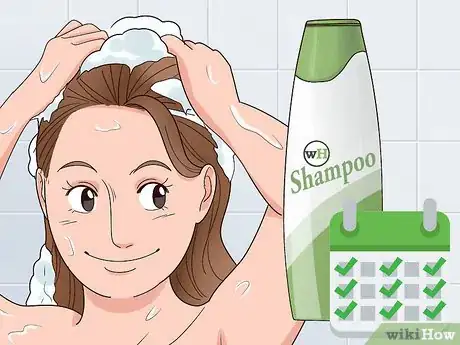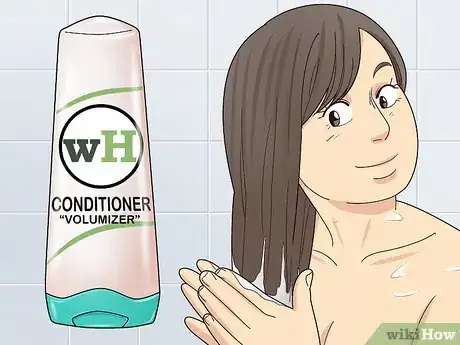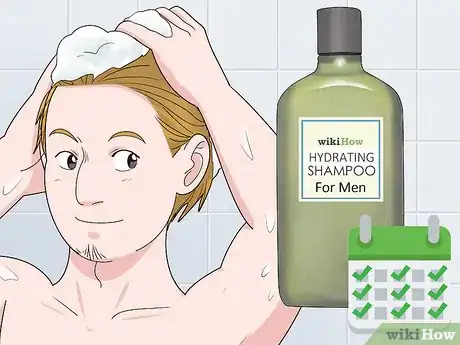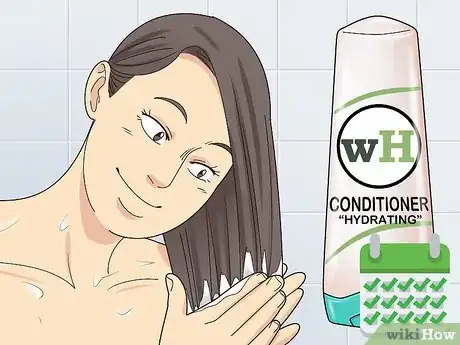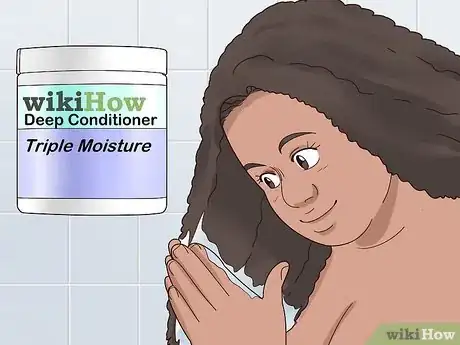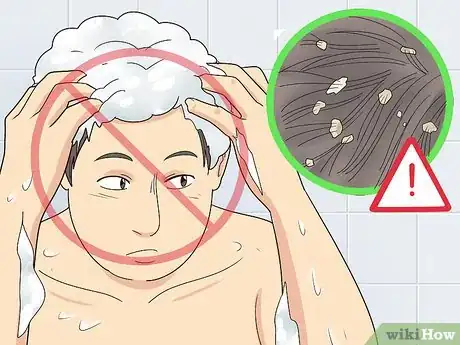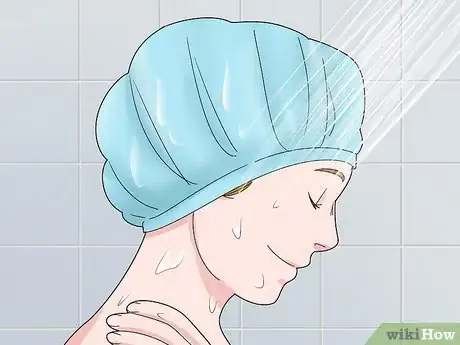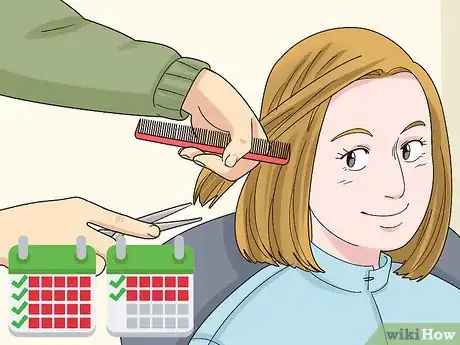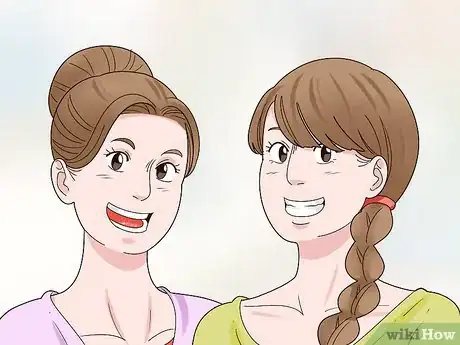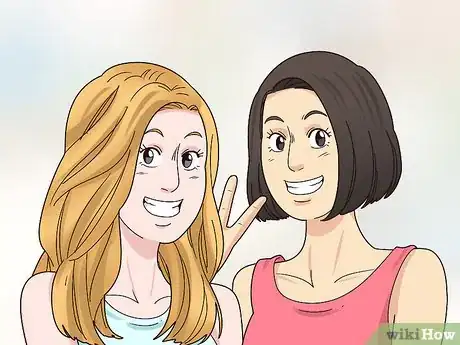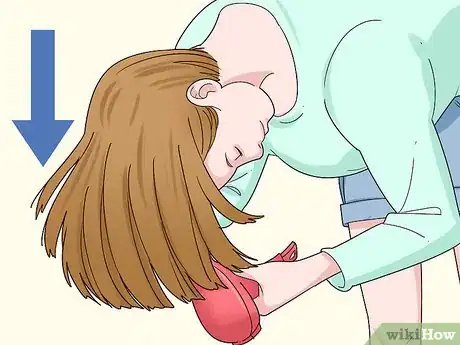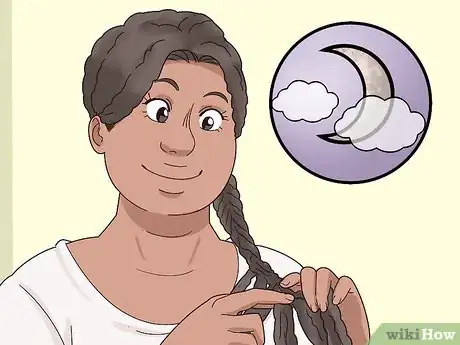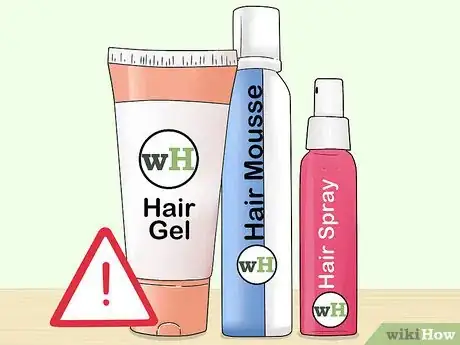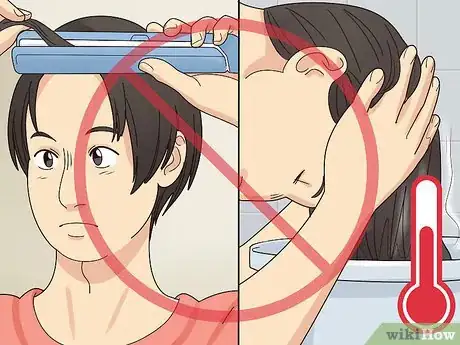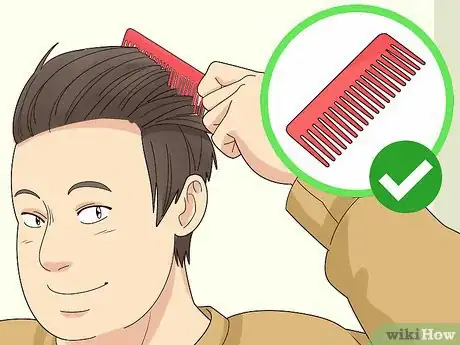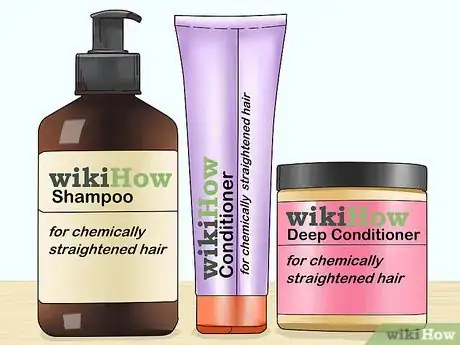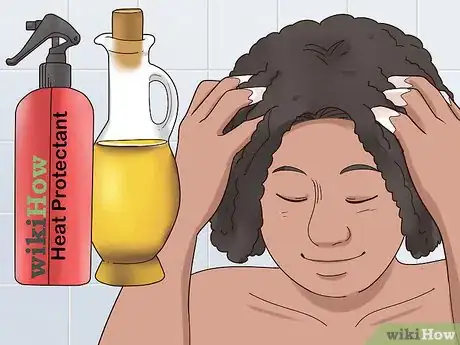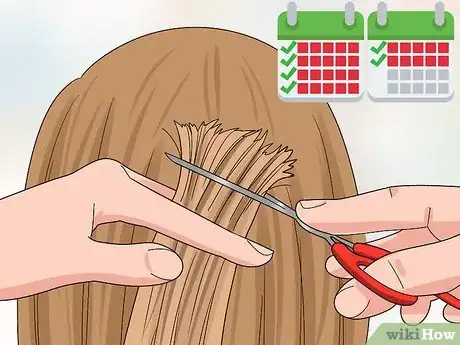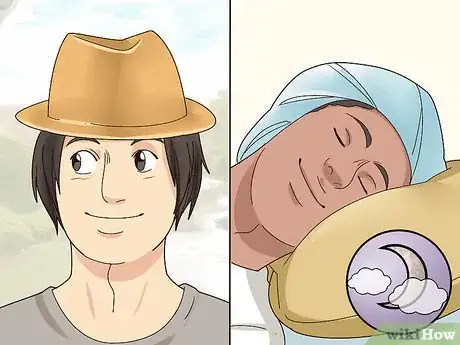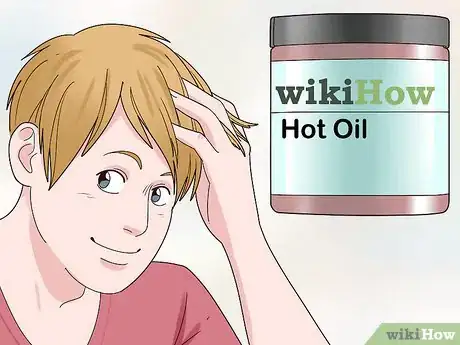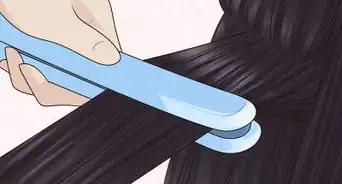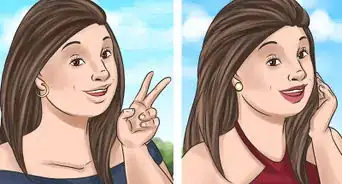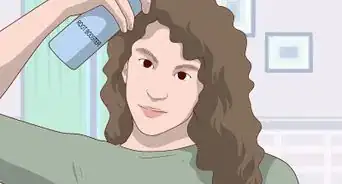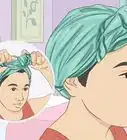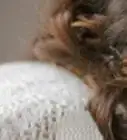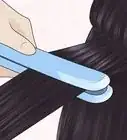This article was co-authored by Christine George. Christine George is a Master Hairstylist, Colorist, and Owner of Luxe Parlour, a premier boutique salon based in the Los Angeles, California area. Christine has over 23 years of hair styling and coloring experience. She specializes in customized haircuts, premium color services, balayage expertise, classic highlights, and color correction. She received her cosmetology degree from the Newberry School of Beauty.
There are 7 references cited in this article, which can be found at the bottom of the page.
This article has been viewed 307,734 times.
Straight hair can often be easy to maintain, but there are some techniques to keep in mind when you're trying to keep it looking its best. You'll want to shampoo and condition your hair appropriately for its thickness, and consider if your hair is naturally straight or chemically straightened when deciding on other style and care techniques.
Steps
Shampooing and Conditioning
-
1Shampoo and condition medium-to-thick straight hair 2-3 times per week. Naturally straight hair that has a medium or thick texture can be shampooed 2-3 times per week, or every other day if you're very active.[1]
- Use a regular or hydrating shampoo, or shampoo for color-treated hair if you use color in your hair.[2]
-
2Shampoo naturally fine, straight hair every day if it's oily. A drawback of naturally straight, fine hair is that it can become oily quickly. The natural oils from your scalp travel faster down your hair if it's straight and this can give it a greasy appearance. If this happens to you, wash your hair every day, or several times per week at minimum.
- Use a shampoo that is labeled as “volumizing” or “lightweight” for the best results.
Advertisement -
3Apply conditioner only at the ends if you have fine straight hair. Naturally fine straight hair can easily be weighed down by conditioners. Use a lightweight or volumizing conditioner on this type of hair, and apply it only at the ends. This will help reduce split ends, while leaving the upper parts of your hair free from the extra weight of conditioner.
-
4Shampoo chemically straightened hair sparingly. If you chemically straighten or relax your hair, it is more susceptible to dryness than non-chemically treated hair. Because shampooing further dries your hair, you should wash your hair as infrequently as you can stand.[3]
- If your hair gets dirty between washes, you can use a dry shampoo as an alternative to washing more often.[4]
- Use a hydrating shampoo or shampoo specifically designed for straightened hair for the best results.
-
5Condition chemically straightened hair daily. While you should shampoo chemically straightened hair infrequently, conditioning it often is a must. Use hydrating conditioner or conditioner designed for straightened hair each day by applying it below the roots and rinsing it with lukewarm water while you're in the shower.[5]
- Use a deep conditioner once per week if your hair begins looking especially dry.
-
6Use deep conditioners and sulfate-free shampoo on relaxed afro-textured hair. Chemically straightened afro-textured hair is especially prone to dryness. Use deep conditioners and leave-in conditioners to keep your hair hydrated and shiny. Sulfates in shampoos dry hair out while cleaning it, so avoid these as well.[6]
- If a deep conditioner needs to be rinsed, be sure to rinse it in lukewarm instead of hot water. Using hot water can further dry out your hair.
-
7Use shampoos and conditioners that are free of chemicals. Certain chemical ingredients are not good for any hair type, including straight and straightened hair.[7] Ingredients to avoid are sulfates, parabens, fragrance, triclosan, and polyethylene glycol.[8]
- These ingredients have been found to be too harsh on the hair and scalp (sulfates and fragrance), cancer-causing (parabens and polyethylene glycol), or linked to immune system problems (triclosan).
- Look for products that are labeled sulfate and paraben free, and naturally fragranced with an essential oil.
-
8Cut back on shampooing if dandruff appears. Sometimes frequent washing of straight hair can cause dandruff, because while the shampoo removes oil from your hair, it also dries out your scalp. The first thing to try if you get dandruff is to reduce how often you wash your hair.[9]
- If you're washing your hair every day, scale back to 2-3 times per week.
- If trying this doesn't help, look for shampoo and conditioner that's specifically designed to treat dandruff. In most cases, the label will state "anti-dandruff." Products containing tea tree oil are also known to help dandruff problems.
-
9Wear a shower cap on days you're not washing your hair. Wetting or rinsing your hair if you're not applying shampoo or conditioner in the shower can quickly dry your hair out. Put your hair under a shower cap during your bath or shower if you're not going to wash it that day.[10]
Styling Naturally Straight Hair
-
1Get your hair trimmed every 4-6 weeks to remove split ends. Straight hair is the hair type that is most susceptible to split ends, or ends that look frayed, dull, and dried out. Combat split ends by getting your hair trimmed regularly, or every 4-6 weeks.
- If trimming that often is not possible for you, try other techniques to prevent split ends such as lessening how often you blow-dry, brushing and combing your hair less frequently, and not combing your hair when it's wet.
- If you're handy with scissors on your own hair, you can also try trimming your own split ends.
-
2Wear your hair in a bun or braids to hide split ends. Sometimes split ends are inevitable on straight hair. To hide them, style your hair in a bun or a braid. If your hair is too short for a bun or braids, try using small clips to twist your hair in several places all over your head instead.
-
3Try a layered haircut or bob to give your hair volume. Straight hair can often look like it lacks volume and bounce. If you'd like your hair to look thicker or bouncier, ask your hair stylist for a layered cut or a bob. If you like having long hair and a bob is too intimidating to you, your stylist can give you suggestions on what type of layered cut would look good on you.
- Check out pictures online or in style books at the hair studio to get more ideas for layered cuts and bobs.
-
4Add volume by blow-drying your hair upside-down. While blow-drying your hair too frequently can dry it out, an blow-dry on thin straight hair can work wonders for adding temporary volume. After you wash and condition your hair, stand with your head down and use a round brush as you apply the air to your hair while it's upside-down.[11]
- Apply a pea-sized amount of lightweight mousse near your roots for an extra volumizing effect if you're trying this technique.
- If you notice that your hair starts becoming dry or damaged, reduce the number of times you blow-dry to 1-2 times per week and add a heat-protectant to your hair before blow-drying. Lowering the temperature setting on your blow-dryer can also reduce damage.
-
5Try braiding your hair at night to add waves. Another way to add temporary volume to your hair is by adding waves to it. Get natural waves in your hair by braiding it when it's wet for the best effect, though braiding it when it's dry works too.
- Sleep with your braids in overnight and take them out in the morning to see the new waves in your hair.
- Make sure your braids are dry before you unravel them. If they're not, you can use a hair dryer on them.
-
6Use gels, mousses, and hairsprays sparingly. Lots of product will weigh down most straight hair. When you need to use these products, use small, pea-sized amounts of gel or mousse, or a few quick squirts of spray, and use ones that are labeled as volumizing or lightweight.
- Products with alcohol in them can contribute to dry hair. Alcohol is most often found in hairsprays and some gels. Try to avoid using products containing alcohol.
Caring for Chemically Straightened Hair
-
1Avoid dry heat and hot water. Chemically straightened or relaxed hair is especially susceptible to becoming dried out. Avoid blow-drying, using curling or flat irons, and washing your hair in hot water as much as possible. When washing and rinsing your hair, use lukewarm water to reduce drying your hair out.[12]
- If you need to blow-dry your hair, try using a heat-protectant spray before you dry.
-
2Comb your hair with a wide-tooth comb before brushing it. To protect your ends from splitting and breaking, use a wide-tooth comb to remove tangles before you brush your hair. Start detangling at the bottom and work your way up to your roots. If your hair is wet or particularly knotted, apply a leave-in conditioner before combing to prevent your hair strands from breaking.[13]
- A wide paddle brush is the best type of brush to use on chemically straightened hair.
-
3Find products specifically designed for chemically straightened hair. Chemically straightened and relaxed hair often requires special moisturizing shampoos, conditioners, and deep conditioners. Try to use these products as often as possible to ensure that your hair is getting enough hydration.[14]
-
4Protect relaxed afro-textured hair with oils and heat protectants. If you're using any type of heat on your relaxed hair, work an oil through your hair with your fingers before using it. There are oils specifically designed for relaxed hair, though regular olive oil from the kitchen works too.[15]
- For heat protectants, find ones that are not alcohol-based, as these can further dry out your hair. Heat protectants infused with keratin proteins are your best bet.
-
5Remedy split ends with a trim every 4-6 weeks. Similar to naturally straight hair, chemically straightened hair is also susceptible to split ends. Try to get your hair trimmed every 4-6 weeks to keep split ends at bay.[16]
- If you're unable to get your hair cut that often, take other preventative measures for split ends such as not blow-drying or heat treating your hair, and not combing it while it's wet.
-
6Protect your hair from breaking with scarves and hats. Chemically treated and relaxed afro-textured hair is more susceptible to damage from the sun than non-treated hair. If you spend time in the sun, protect your hair with a stylish hat or scarf.[17]
- Relaxed afro-textured hair is also prone to breakage while you're sleeping, so try wrapping your hair in a scarf overnight. For best results, choose a scarf that's made of silk.
-
7Use hot oil remedies for hair that's looking dry. Your hair may begin to get dry if it's chemically straightened or relaxed, even if you take preventative measures. Hot oil treatments can be used up to once per week for dry, damaged hair.[18]
- Look for hot oil products that are specifically designed for chemically treated or relaxed hair.
- Hot oil products may differ in terms of application techniques. Follow the instructions on the packaging for the best results.
Expert Q&A
Did you know you can get expert answers for this article?
Unlock expert answers by supporting wikiHow
-
QuestionHow do you take care of chemically straightened hair?
 Christine GeorgeChristine George is a Master Hairstylist, Colorist, and Owner of Luxe Parlour, a premier boutique salon based in the Los Angeles, California area. Christine has over 23 years of hair styling and coloring experience. She specializes in customized haircuts, premium color services, balayage expertise, classic highlights, and color correction. She received her cosmetology degree from the Newberry School of Beauty.
Christine GeorgeChristine George is a Master Hairstylist, Colorist, and Owner of Luxe Parlour, a premier boutique salon based in the Los Angeles, California area. Christine has over 23 years of hair styling and coloring experience. She specializes in customized haircuts, premium color services, balayage expertise, classic highlights, and color correction. She received her cosmetology degree from the Newberry School of Beauty.
Master Hair Stylist & Colorist
-
QuestionCan you wash your hair after a keratin treatment?
 Laura MartinLaura Martin is a Licensed Cosmetologist in Georgia. She has been a hair stylist since 2007 and a cosmetology teacher since 2013.
Laura MartinLaura Martin is a Licensed Cosmetologist in Georgia. She has been a hair stylist since 2007 and a cosmetology teacher since 2013.
Licensed Cosmetologist
-
QuestionWhat should I do after getting my hair straightened?
 Laura MartinLaura Martin is a Licensed Cosmetologist in Georgia. She has been a hair stylist since 2007 and a cosmetology teacher since 2013.
Laura MartinLaura Martin is a Licensed Cosmetologist in Georgia. She has been a hair stylist since 2007 and a cosmetology teacher since 2013.
Licensed Cosmetologist
References
- ↑ https://www.glamour.com/gallery/best-products-for-straight-hair
- ↑ Christine George. Master Hair Stylist & Colorist. Expert Interview. 10 January 2020.
- ↑ https://www.bebeautiful.in/all-things-hair/everyday/care-for-permanently-straightened-hair
- ↑ Christine George. Master Hair Stylist & Colorist. Expert Interview. 10 January 2020.
- ↑ https://www.bebeautiful.in/all-things-hair/everyday/care-for-permanently-straightened-hair
- ↑ http://www.glamourmagazine.co.uk/article/how-to-care-for-afro-hair
- ↑ Christine George. Master Hair Stylist & Colorist. Expert Interview. 10 January 2020.
- ↑ https://www.care2.com/greenliving/5-ingredients-to-avoid-in-your-hair-products.html
- ↑ https://raisingwhasians.com/winter-hair-care-tips-for-straight-hair/
- ↑ https://raisingwhasians.com/winter-hair-care-tips-for-straight-hair/
- ↑ Christine George. Master Hair Stylist & Colorist. Expert Interview. 10 January 2020.
- ↑ https://www.bebeautiful.in/all-things-hair/everyday/care-for-permanently-straightened-hair
- ↑ http://www.glamourmagazine.co.uk/article/how-to-care-for-afro-hair
- ↑ https://www.bebeautiful.in/all-things-hair/everyday/care-for-permanently-straightened-hair
- ↑ https://www.cosmopolitan.com/uk/beauty-hair/hair/advice/a34769/top-tips-for-straightening-curly-hair/
- ↑ https://www.bebeautiful.in/all-things-hair/everyday/care-for-permanently-straightened-hair
- ↑ http://www.glamourmagazine.co.uk/article/how-to-care-for-afro-hair
- ↑ https://www.bebeautiful.in/all-things-hair/everyday/care-for-permanently-straightened-hair
